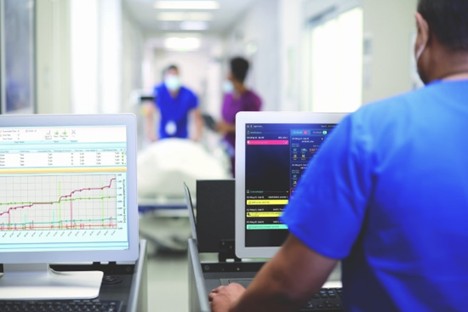For over 40 years, the medical device industry has made incremental progress toward interoperability, yet data silos, vendor lock-in, and fragmented system integrations continue to hinder AI-driven innovation, real-time patient monitoring, and cost-effective care delivery. The lack of adoption and implementation of consensus-based, plug-and-play interoperability standards has resulted in increased integration costs, reduced efficiency, and limited scalability for device manufacturers and healthcare providers alike.
Now, HL7’s Device Interoperability FHIR Accelerator is tackling these long-standing challenges decisively. This new initiative brings together IEEE, ISO, IHE, and MedTech leaders to finally establish a unified, scalable framework for medical device data exchange—one that is vendor-agnostic, future-proof, and designed to support AI-driven automation and real-time decision-making.
The Interoperability Roadblock in MedTech Innovation
The lack of plug-and-play interoperability in medical devices continues to pose a major challenge for both care delivery and innovation. Research on medical device interoperability by UNITY Consulting, found isolation rooms and quiet ICUs are in high-demand for enabling centralized monitoring and reducing staff exposure. Yet satisfaction with current solutions remains low. These gaps reinforce the clinical demand for plug-and-play systems that are purpose-built to meet complex, high-acuity care needs.
At the same time, healthcare is rapidly expanding beyond the four walls of the hospital. Hospital-at-home programs and mobile health technologies are advancing, but most still rely on proprietary, siloed connectivity. HL7’s FHIR standard, originally conceived with home and mobile device integration in mind, is uniquely positioned to support this evolution.
For medical device innovators, the lack of open, standards-based connectivity remains a significant barrier to entry. Without a common framework, developers are forced to build one-off integrations for each health system, slowing time to market and limiting scalability. By extending interoperability to include consumer-grade and clinic-based devices, the industry can accelerate innovation, reduce integration costs, and ensure continuity of care across all settings.
Without plug-and-trust, vendor-independent interoperability; hospitals, payers and patients alike will continue to bear the financial and clinical consequences of a fragmented device ecosystem.
HL7’s Vision for Plug-and-Play Interoperability
HL7’s Device Interoperability FHIR Accelerator aims to move beyond incremental progress toward true plug-and-play interoperability, where medical devices can seamlessly connect device-to-device as well as to EHRs and health IT systems without costly custom integrations. This builds on decades of work, including the HL7 Devices on FHIR initiative and the ISO/IEEE 11073 standards, to create a framework that supports real-time, high-fidelity device data exchange.
By leveraging FHIR-based APIs, medical devices can achieve instant compatibility with certified EHR systems, reducing integration complexity and enabling hospitals to implement new technologies faster.
The Business Case for Device Manufacturers
For medical device manufacturers, plug-and-play interoperability presents a compelling business case. The lack of standardized data exchange results in substantial integration costs and slower market adoption. Hospitals spend over $1.1 billion annually on medical device integration, with 66% of these costs reducible through standardized interoperability solutions. The current model forces hospitals to allocate significant resources to custom API development, increasing operational expenses.
Moreover, the cost of integrating medical devices with EHRs is estimated at $10,000 per hospital bed in one-time costs, plus 15% annual maintenance fees. This places a significant financial strain on health systems, incentivizing them to favor plug-and-play devices that reduce integration overhead.
For device manufacturers, proprietary interfaces create barriers to widespread adoption. Manufacturers spend over $430 million annually on redundant R&D efforts to make their products work with different EHRs. By shifting to standards-based, FHIR-enabled device interoperability, manufacturers can reduce development costs while expanding their market reach.
Enabling AI-Driven MedTech Solutions
AI and machine learning applications in MedTech depend on structured, high-quality data, yet, 80% of healthcare data remains unstructured. AI systems require clean, real-time data inputs to generate accurate, actionable insights for clinical decision support, early warning systems, and personalized medicine.
Interoperability standards, particularly HL7 FHIR, provide a structured framework to ensure that AI-driven technologies have access to consistent, high-fidelity device data.
This is essential for:
- AI-powered patient monitoring: Real-time streaming of device data allows AI to detect early signs of deterioration and alert care teams before adverse events occur.
- Predictive analytics: By analyzing large-scale, structured data, AI can help forecast disease progression, optimize ICU management, and improve triage decisions.
- AI-assisted diagnostics: Seamless device interoperability allows AI-driven imaging, lab analysis, and biosensor data interpretation to be integrated directly into provider workflows.
Why Now? The Industry Push for Standards
The push for medical device interoperability is gaining momentum, with federal agencies like CMS and ONC mandating FHIR-based APIs as part of their broader strategy to improve health data exchange. The Interoperability and Prior Authorization Final Rule (CMS-0057-F) now requires payers to implement FHIR-based APIs, setting the stage for greater standardization across healthcare.
Similarly, the Trusted Exchange Framework and Common Agreement (TEFCA) is expanding its interoperability requirements to support FHIR API exchanges, further aligning the industry toward a standardized approach.
The Time for Industry Collaboration is Now
As the healthcare industry moves toward a future where seamless, real-time device interoperability is the norm, stakeholders, including device manufacturers, healthcare providers and policymakers, must come together to support the adoption and implementation of open, standards-based solutions.
By uniting around plug-and-play interoperability, the industry can unlock a new era of MedTech innovation; one where device data flows effortlessly, AI applications enhance efficiencies, and hospitals reduce burdens of proprietary integrations.
The transition to a standards-based ecosystem is no longer a distant goal but a strategic imperative that will define the future of medical technology. Organizations that take action now will be at the forefront of this transformation, shaping a more connected, efficient and patient-centered healthcare system.
MedTech Intelligence Content Partner
HL7 invites all interested stakeholders to become founding members of the Device Interoperability FHIR Accelerator and help drive the next era of MedTech innovation.
For more information, email to devices@hl7.org.








